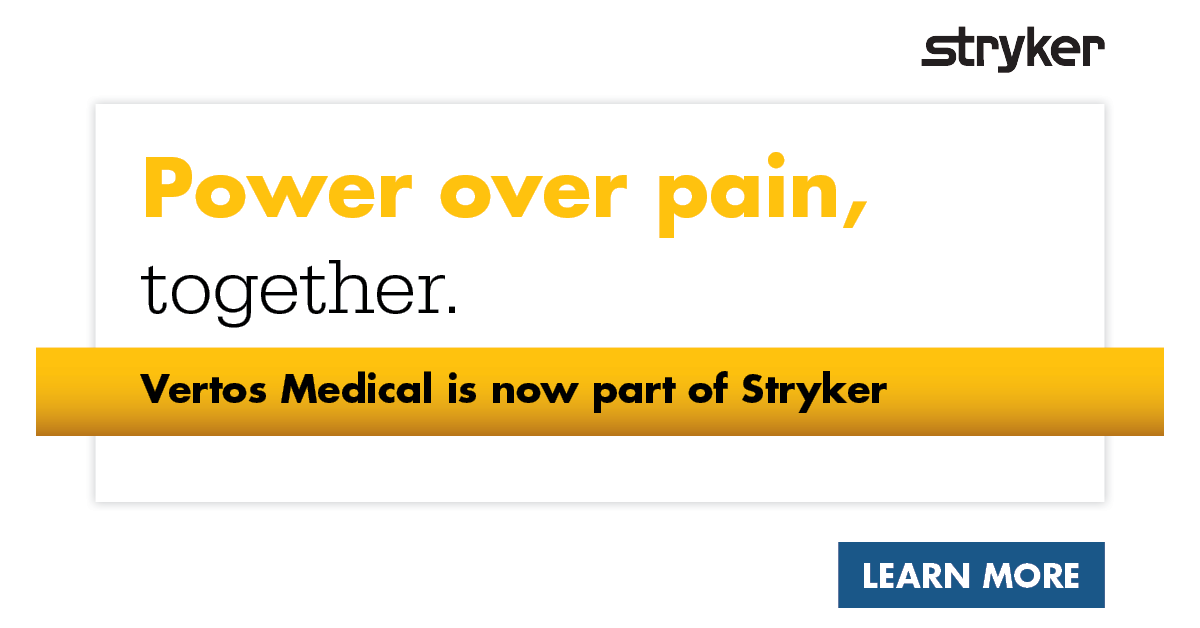Case Studies: Leading Physicians are Moving a Broad Spectrum of Patients to mild®
Published March 31, 2021
Discover how leading interventionalists across the country have helped lumbar spinal stenosis patients with the minimally invasive mild® Procedure. The case studies below illustrate how mild® has helped a broad spectrum of patients increase mobility, reduce pain, and restore their quality of life. From patient identification to significant outcomes, read on to learn about the medical knowledge shared by these expert mild® providers.
Patient (67) Finds Lasting Relief with mild®
This case study highlights a female patient, age 67, with debilitating back pain that rated 9-10 on a 10 point pain scale. Her pain prevented her from completing daily tasks and decreased her quality of life.
Despite multiple interventions, including epidural steroid injections (ESIs), facet injections, and medication therapy, the patient continued to experience chronic pain. The patient had no previous surgical history and was not a surgical candidate.
An MRI was performed, which found multiple levels of stenosis at levels (L3-4 and L4-L5) and several spinal comorbidities, including disc protrusion, ligamentum flavum hypertrophy, and severe spinal stenosis.
Dr. Puri, a leading pain medicine specialist at Relievus Pain Management, decided to make the move to mild® and help this patient find the lasting relief she was looking for. After the mild® Procedure, the patient was able to walk and stand twice as long, noting her pain score went from 9-10/10 to 3/10.
Shawn Puri, MD
Relievus Pain Management
Read the Full Case Study
Patient (71) with Multiple Comorbidities Finds Relief with mild®
In this case study, a male patient, age 71, presented with multiple spinal comorbidities including lateral recess narrowing, facet arthropathy, and hypertrophic ligamentum flavum.
He was previously treated with L5-S1 laminectomy in 1982 and more recently with ESIs and lumbar neurotomy with limited pain relief. An MRI confirmed lumbar spinal stenosis with hypertrophic ligamentum flavum at L3-L4 and L4-L5.
Four weeks after the mild® Procedure, the patient experienced VAS 0/10, down from VAS 8-10/10 before mild®. Dr. Calodney shared, “This patient went from being unable to stand for more than 5–10 minutes to playing golf one month after the procedure. The mild® Procedure has enabled him to travel with his wife and play golf–his two favorite pastimes.”
Aaron Calodney, MD
Precision Spine Care, Baylor Scott & White Texas Spine & Joint Hospital
Read the Full Case Study
Patient (75) Walker and Cane-Free Days After mild®
After three back surgeries, a male patient, age 75, was still having trouble standing for more than 10 minutes. He had “several symptoms of neurogenic claudication, including limited standing and walking time and interrupted sleep.” He also had an extensive treatment history, including physical therapy, three back surgeries including open decompression and laminectomies, ESIs and pain medication with little to no improvement for his back pain.
Dr. Khemlani performed the mild® Procedure on levels L3-L4 at an outpatient surgery center and the patient was instructed to, “resume normal activity within 24 hours with no restrictions.” Just two days after the mild® Procedure, the patient “threw out his cane and walker” and resumed walking up to two miles. He looked forward to his first hike in a year with his wife.
The patient reported an NPRS improvement from 8/10 before mild® to 1-2/10 two weeks post-procedure, which eliminated his need for pain medication. Dr. Khemlani said, “The patient feels the changes have given him his life back!”
Vishal Khemlani, MD
Columbia Pain Management, P.C.
Read the Full Case Study
Patient (77) with Extensive Medical History Moves on from ESIs and Finds Relief with mild®
In this study, a female patient, age 77, with a history of “hypertension, AFib, asthma and GERD” had back pain that was registering at 9/10 VAS. Even with a five-year history of ESIs with another provider, symptoms of neurogenic claudication were present and she was unable to stand or walk for more than five minutes. Lumbar spinal stenosis with hypertrophic ligamentum flavum was confirmed through an MRI.
Dr. Pryzbylkowski moved on from ESIs and advanced the patient to the mild® Procedure, treating levels L3-L4 bilaterally. Within two weeks, the patient was at 0/10 VAS and was able to stand or walk for 10 minutes. After six weeks, the patient could stand for 25 minutes and was not taking any pain medication while reporting significant pain improvement.
 Peter Pryzbylkowski, MD
Peter Pryzbylkowski, MD
Relievus Pain Management Group; NJ & PA
Read the Full Case Study
mild® Helps Patient (68) After Conservative Care Offers Little Relief
After a “full course of physical therapy was completed with very little improvement,” a male patient, age 68, had a pain score of 9/10 with ambulation. A mobility assessment was performed and concluded he was “unable to walk or stand 5-10 minutes without seeking relief through flexion or rest.” He had a history of failed physical therapy, chiropractic care, and epidural injections and no response to gabapentinoids, opioids, or NSAIDS.
Dr. Deer and his team performed the mild® Procedure on levels L3-L4 and L4-L5 in an outpatient surgery center. Two weeks after the procedure, “the patient reported that the changes are ‘UNREAL.’” The case study highlights that post-mild®, the patient was able to stand more than 30 minutes without the need for rest and achieved an impressive 8-point pain reduction from 9/10 to 1/10 (VAS). Other people noticed the change too in this patient, especially in his ability to stand upright. His wife, family, and church family noticed how much straighter he is standing.

 Timothy Deer, MD, and Ashley Comer, APRN, NP-C
Timothy Deer, MD, and Ashley Comer, APRN, NP-C
The Spine & Nerve Centers of the Virginias
Read the Full Case Study
Patient (53) Recovers After Chronic Back Pain, Thanks to mild®
A male patient, age 53, had “chronic back and leg pain, and had tried and failed multiple interventional pain therapies over an eight year period.” He was “unable to stand for more than five minutes.”
The patient was experiencing symptoms of neurogenic claudication and hypertrophic ligamentum flavum was confirmed through a CT scan. Dr. Bux stated, “We generally use MRI imaging to confirm [lumbar spinal stenosis] and to look for the ligament, but the pain pump eliminated this as an option.”
Three weeks after the mild® Procedure, which treated levels L2-L3 and L3-L4, the patient felt better than he had in eight years! His functional improvement allowed him to stand longer, stand up straight and, best of all, work in his wood shop again.

 Anjum Bux, MD and Kyla Anderson, APRN
Anjum Bux, MD and Kyla Anderson, APRN
Bux Pain Management
Read the Full Case Study
Active Patient (75) Gets Back to What She Loves After mild®
This case highlights an active female patient, age 75, with a history of low back pain for over three years, which gradually worsened with standing and walking. She had not found relief with other providers and was sent to Dr. Qu for further evaluation.
She had a two-year history of ESIs and other procedures, including therapeutic lumbar facet injections, two sets of RF ablation procedures and one bilateral SI joint injection. Dr. Qu stated, “When patients report symptoms of [neurogenic claudication] and the [hypertrophic ligamentum flavum] is present on the MRI, I know the ligament is the main pain generator. With mild®, I can help remove the source of the problem and get patients functioning again with less pain.”
Dr. Qu performed the mild® Procedure, and treated the left L4-L5, unilaterally. Four weeks post-procedure, the patient’s mobility increased significantly and VAS decreased from 5-7/10 to 0/10 with no additional treatments or medications. She “attended a convention in Salt Lake City and walked all over the city for a whole week without back pain.” The patient was so pleased, she called the procedure and Dr. Qu a “blessing.” Dr. Qu goes on to say “mild® patient outcomes are powerful and provide great word-of-mouth for my practice.”
 David Qu, MD
David Qu, MD
Pennsylvania Pain & Spine Institute
Read the Full Case Study
Physician Helps Father (82) with Comorbidities Reduce Pain and Eliminate Pain Medication with mild®
Dr. Jassal has a special connection with this patient case. He said, “something that I have always told my patients is I would do this on my own family members. This case example is of my father.”
Dr. Jassal’s father, age 82, had a history of diabetes and, after several lumbar interventions, was still not able to walk more than 15 feet without the assistance of a cane. He was not a good surgical candidate due to his medical history. The study states that an MRI, “confirmed central canal stenosis with hypertrophic ligamentum flavum.”
Dr. Jassal performed the mild® Procedure on L3-L4 and L4-L5 bilaterally, and, two weeks after the outpatient procedure, his father achieved a standing time of 10 minutes and walked a quarter of a mile without a cane. Fifteen weeks after the procedure, he had 7-point pain reduction from 10/10 to 3/10 (VAS). His need for pain medication was eliminated and he had continued pain relief in legs and back.
A key takeaway from Dr. Jassal was “We are not just looking for hypertrophic ligamentum flavum for these patients. Of course, to offer them mild® they must have hypertrophic ligamentum flavum, but we don’t exclude patients with comorbidities!”
 Navdeep Jassal, MD
Navdeep Jassal, MD
Spine & Pain Institute of Florida
Read the Full Case Study
mild® Helps Patient (71) Reduce Pain and Improve Quality of Life After ESIs Are No Longer Effective
A male patient, age 71, presented with severe back pain that prevented him from performing his duties as a bus driver, as well as taking trips to the market. He experienced limited mobility and was unable to stand for more than 2 or 3 minutes. The patient underwent failed interventions with other providers, including multiple epidural steroid injections (ESIs), and finally found relief with Dr. Coleman.
Dr. Coleman performed the mild® Procedure on three levels bilaterally via the Streamlined Technique, which uses a single midline incision to access multiple treatment zones. Upon discharge, the patient was instructed to return to normal activities within 24 hours with no restrictions.
One week post-procedure, the patient was able to walk for more than 20 minutes, up from less than 3 minutes before mild®. The patient reported 100% pain relief and a VAS improvement from 5/10 before mild® to 0/10. He was able to get back to simple everyday activities, like grocery shopping. There is even a chance he could return to work as a bus driver!
Dr. Coleman emphasizes that “This patient is a perfect example of how imperative it is to move on from ESIs when they are no longer effective.”
Mark Coleman, MD
National Spine & Pain Centers
Read the Full Case Study
As Vertos Medical partners with the nation’s leading healthcare providers, we work to ensure that lumbar spinal stenosis patients have access to the mild® Procedure as a treatment option. Performed through a single, tiny incision, mild® is a minimally invasive lumbar decompression procedure that removes a major root cause of neurogenic claudication by debulking the hypertrophic ligamentum flavum, which reduces the compression of the nerves. Learn more about how mild® can be a valuable part of your practice.





